I've always had a strong feeling for the satue of Libertty,
because it become the satue of my personal
liberty.
I have a wonderful make-up crew. They're the same people restoring the
Statue of Liberty.
Bob Hope
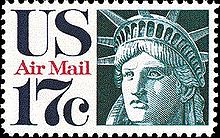
As an American icon, the Statue of Liberty has been depicted on the country's
coinage and stamps. It appeared on commemorative coins issued to mark its 1986
centennial, and on New York's 2001 entry in the
state quarters series. An
image of the statue was chosen for the
American Eagle platinum bullion coins in 1997,
and it was placed on the
reverse, or "tails", side of the
Presidential
Dollar series of circulating coin Two
images of the statue's torch appear on the current
ten-dollar bill. The
statue's intended photographic depiction on a 2010
forever stamp proved instead to be of the replica
at the Las Vegas
Depictions of the statue have been used by many regional institutions.
Between 1986 and 2000, New York State issued
license plates featuring the statue.The
Women's National Basketball Association's
New York Liberty use both the statue's name and
its image in their logo, in which the torch's flame doubles as a basketball.The
New York Rangers of the
National
Hockey League depicted the statue's head on their
third
jersey, beginning in 1997. The
National Collegiate Athletic Association's
1996 Men's Basketball Final Four, played at New
Jersey's
Meadowlands Sports Complex, featured the statue
in its logo. The
Libertarian Party of the United States uses the
statue in its emblem.
The statue is a frequent subject in popular culture. In music, it has been
evoked to indicate support for American policies, as in
Toby
Keith's song "
Courtesy of the Red, White, & Blue (The Angry
American)", and in opposition, appearing on the cover of
The Dead Kennedys' album
Bedtime
for Democracy, which protested the Reagan administration. In
film, the torch is the setting for the climax of director
Alfred Hitchcock's 1942 movie
Saboteur. The
statue makes one of its most famous cinematic appearances in the 1968 picture
Planet of the Apes, in which it is seen
half-buried in sand. It
is destroyed in the science-fiction films
Independence
Day,
The Day After Tomorrow, and
Cloverfield. In
Jack Finney's time-travel novel
Time
and Again, the right arm of the statue, on display in the
early 1880s in Madison Square Park, plays a crucial role
Robert Holdstock, consulting editor of
The Encyclopedia of Science Fiction, wondered
in 1979,
Where would [science fiction] be without the Statue of Liberty? For decades
it has towered or crumbled above the wastelands of deserted [E]arth—giants have
uprooted it, aliens have found it curious ... the symbol of Liberty, of
optimism, has become a symbol of science fiction's pessimistic view of the
future."
[

Design, style,
and symbolism
Detail from a fresco by
Constantino Brumidi in the
U.S.
Capitol in
Washington, D.C., showing two early symbols of
America:
Columbia (left) and the Indian
princess
Bartholdi and Laboulaye considered how best to express the idea of American
liberty. In
early American history, two female figures were frequently used as cultural
symbols of the nation.One,
Columbia, was seen as an embodiment of the United
States in the manner that
Britannia was identified with the United Kingdom
and
Marianne came to represent France. Columbia had
supplanted the earlier figure of an
Indian princess, which had come to be regarded as
uncivilized and derogatory toward Americans. The
other significant female icon in American culture was a representation of
Liberty, derived from
Libertas, the
goddess of freedom widely worshipped in
ancient Rome, especially among
emancipated slaves. A Liberty figure adorned most
American coins of the time,and
representations of Liberty appeared in popular and civic art, including
Thomas Crawford's
Statue of Freedom (1863) atop the dome of the
United States Capitol Building.
Artists of the 18th and 19th centuries striving to evoke
republican
ideals commonly used representations of Liberty. A
figure of Liberty was also depicted on the
Great Seal of France.
However, Bartholdi and Laboulaye avoided an image of revolutionary liberty such
as that depicted in
Eugène Delacroix's famed
Liberty
Leading the People (1830). In this painting, which
commemorates France's
Revolution of 1830, a half-clothed Liberty leads
an armed mob over the bodies of the fallen.
Laboulaye had no sympathy for revolution, and so Bartholdi's figure would be
fully dressed in flowing robes.
Instead of the impression of violence in the Delacroix work, Bartholdi wished to
give the statue a peaceful appearance and chose a torch, representing progress,
for the figure to hold.
Crawford's statue was designed in the early 1850s. It was originally to be
crowned with a
pileus, the cap given to emancipated slaves
in ancient Rome.
Secretary of War Jefferson Davis, a Southerner who would later
serve as
president of the
Confederate States of America, was concerned that
the
pileus would be taken as an
abolitionist symbol. He ordered that it be
changed to a helmet.
Delacroix's figure wears a
pileus, and
Bartholdi at first considered placing one on his figure as well. Instead, he
used a
diadem, or crown, to top its head. In so
doing, he avoided a reference to Marianne, who invariably wears a
pileus. The
seven rays form a halo or
aureole. They
evoke the sun, the seven seas, and the seven continents,and
represent another means, besides the torch, whereby Liberty enlightens the
world.
Bartholdi's early models were all similar in concept: a female figure in
neoclassical style representing liberty, wearing a
stola and
pella (gown and cloak,
common in depictions of Roman goddesses) and holding a torch aloft. The face was
modeled after that of Charlotte Beysser Bartholdi, the sculptor's mother.He
designed the figure with a strong, uncomplicated silhouette, which would be set
off well by its dramatic harbor placement and allow passengers on vessels
entering
New York Bay to experience a changing perspective
on the statue as they proceeded toward Manhattan. He gave it bold classical
contours and applied simplified modeling, reflecting the huge scale of the
project and its solemn purpose.
Bartholdi wrote of his technique:
Thomas Crawford's
Statue of Freedom The surfaces should be broad and simple, defined by a bold and clear design,
accentuated in the important places. The enlargement of the details or their
multiplicity is to be feared. By exaggerating the forms, in order to render them
more clearly visible, or by enriching them with details, we would destroy the
proportion of the work. Finally, the model, like the design, should have a
summarized character, such as one would give to a rapid sketch. Only it is
necessary that this character should be the product of volition and study, and
that the artist, concentrating his knowledge, should find the form and the line
in its greatest simplicity.
Bartholdi made alterations in the design as the project evolved. Bartholdi
considered having Liberty hold a broken chain, but decided this would be too
divisive in the days after the Civil War. The erected statue does rise over a
broken chain, half-hidden by her robes and difficult to see from the ground.
Bartholdi was initially uncertain of what to place in Liberty's left hand; he
settled on a
tabula ansata, a keystone-shaped tablet used
to evoke the concept of law.
Though Bartholdi greatly admired the
United States Constitution, he chose to inscribe
"JULY IV MDCCLXXVI" on the tablet, thus associating the date of the country's
Declaration of Independence with the concept of
liberty.
Consultations with the metalwork foundry Gaget, Gauthier & Co. led
Bartholdi to conclude that the skin should be made of copper sheets, beaten to
shape by the
repoussé method. An
advantage of this choice was that the entire statue would be light for its
volume—the copper need be only .094 inches (2.4 mm) thick. He decided on a
height of just over 151 feet (46 m) for the statue, double that of Italy's
Colosso di San Carlo Borromeo and
the
German statue of
Arminius, both made with the same method.
Bartholdi interested a former teacher of his, architect
Eugène
Viollet-le-Duc, in the project. Viollet-le-Duc planned to
construct a brick
pier within the statue, to which the skin would
be anchored.
Height 151 feet 1 inch (46 meters) Ground to torch: 305 feet 1 inch (93 meters)
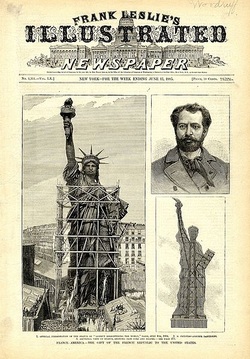
Fundraising, criticism, and construction in the United StatesFrank Leslie's Illustrated Newspaper, June 1885, showing
woodcuts of the completed statue in Paris, Bartholdi, and the statue's interior structureThe committees in the United States faced great difficulties in obtaining funds. The
Panic of 1873 had led to an economic depression that persisted through much of the decade. The Liberty statue project was not the only such undertaking that had difficulty raising money: construction of the obelisk later known as the
Washington Monument sometimes stalled for years; it would ultimately take over three-and-a-half decades to complete. There was criticism both of Bartholdi's statue and of the fact that the gift required Americans to foot the bill for the pedestal. In the years following the Civil War, most Americans preferred realistic artworks depicting heroes and events from the nation's history, rather than allegorical works like the Liberty statue. There was also a feeling that Americans should design American public works—the selection of Italian-born
Constantino Brumidi to decorate the Capitol had provoked intense criticism, even though he was a naturalized U.S. citizen.
Harper's Weekly declared its wish that "M. Bartholdi and our French cousins had 'gone the whole figure' while they were about it, and given us statue and pedestal at once.
The New York Times stated that "no true patriot can countenance any such expenditures for bronze females in the present state of our finances." Faced with these criticisms, the American committees took little action for several years.
The foundation of Bartholdi's statue was to be laid inside
Fort Wood, a disused army base on Bedloe's Island constructed between 1807 and 1811. Since 1823, it had rarely been used, though during the Civil War, it had served as a recruiting station.The fortifications of the structure were in the shape of an eleven-point star. The statue's foundation and pedestal were aligned so that it would face southeast, greeting ships entering the harbor from the Atlantic Ocean.In 1881, the New York committee commissioned
Richard Morris Hunt to design the pedestal. Within months, Hunt submitted a detailed plan, indicating that he expected construction to take about nine months. He proposed a pedestal 114 feet (35 m) in height; faced with money problems, the committee reduced that to 89 feet (27 m).
[
[
Hunt's pedestal design contains elements of classical architecture, including Doric portals, and the large mass is fragmented with architectural detail to focus attention on the statue. In form, it is a truncated pyramid, 62 feet (19 m) square at the base and 39.4 feet (12.0 m) at the top. The four sides are identical in appearance. Above the door on each side, there are ten disks upon which Bartholdi proposed to place the coats of arms of the states (between 1876 and 1889, there were 40 U.S. states), although this was not done. Above that, a balcony was placed on each side, framed by pillars. Bartholdi placed an observation platform near the top of the pedestal, above which the statue itself rise According to author Louis Aurchinloss, the pedestal "craggily evokes the power of an ancient Europe over which rises the dominating figure of the Statue of Liberty". The committee hired former army General Charles Pomeroy Stone to oversee the construction work. Construction on the 15-foot (4.6 m) deep foundation began in 1883, and the pedestal's cornerstone was laid in 1884. In Hunt's original conception, the pedestal was to have been made of solid granite . Financial concerns again forced him to revise his plans; the final design called for poured concrete walls, up to 20 feet (6.1 m) thick, faced with granite blocks. The concrete mass was the largest poured to that time.
Fundraising for the statue had begun in 1882. The committee organized a large number of money-raising events. As part of one such effort, an auction of art and manuscripts, poet Emma Lazarus was asked to donate an original work. She initially declined, stating she could not write a poem about a statue. At the time, she was also involved in aiding refugees to New York who had fled anti-Semitic pogroms in eastern Europe. These refugees were forced to live in conditions that the wealthy Lazarus had never experienced. She saw a way to express her empathy for these refugees in terms of the statue.The resulting sonnet, "The New Colossus'', including the iconic lines "Give me your tired, your poor/Your huddled masses yearning to breathe free", is uniquely identified with the Statue of Liberty and is inscribed on a plaque in the museum in the base.
Richard Morris Hunt's pedestal under construction in June 1885Even with these efforts, fundraising lagged.Grover Claveland, the govermor of New York, vetoed a bill to provide $50,000 for the statue project in 1884. An attempt the next year to have Congress provide $100,000, sufficient to complete the project, failed when Democratic representatives would not agree to the appropriation. The New York committee, with only $3,000 in the bank, suspended work on the pedestal. With the project in jeopardy, groups from other American cities, including Boston and Philadelphia, offered to pay the full cost of erecting the statue in return for relocating it
Joseph Pulitzer, publisher of the World, a New York newspaper, announced a drive to raise $100,000 (the equivalent of $2.3 million today). Pulitzer pledged to print the name of every contributor, no matter how small the amount given. The drive captured the imagination of New Yorkers, especially when Pulitzer began publishing the notes he received from contributors. "A young girl alone in the world" donated "60 cents, the result of self denial." One donor gave "five cents as a poor office boy's mite toward the Pedestal Fund." A group of children sent a dollar as "the money we saved to go to the circus with." Another dollar was given by a "lonely and very aged woman." Residents of a home for alcoholics in New York's rival city of Brooklyn (the cities would not merge until 1898) donated $15; other drinkers helped out through donation boxes in bars and saloons.A kindergarten class in Davenpor lowa, mailed the
World a gift of $1.35.
As the donations flooded in, the committee resumed work on the pedestal. In June, New Yorkers displayed their new-found enthusiasm for the statue, as the French vessel
Isère arrived with the crates holding the disassembled statue on board. Two hundred thousand people lined the docks and hundreds of boats put to sea to welcome the
Isère. After five months of daily calls to donate to the statue fund, on August 11, 1885, the
World announced that $102,000 had been raised from 120,000 donors, and that 80 percent of the total had been received in sums of less than one dollar.
Even with the success of the fund drive, the pedestal was not completed until April 1886. Immediately thereafter, reassembly of the statue began. Eiffel's iron framework was anchored to steel l-beams within the concrete pedestal and assembled. Once this was done, the sections of skin were carefully attached. Due to the width of the pedestal, it was not possible to erect scaffolding, and workers dangled from the armature by ropes while installing the skin sections. Nevertheless, no one died during the construction work. Bartholdi had planned to put floodlights on the torch's balcony to illuminate it; a week before the dedication, the Army Corps of Enqineers vetoed the proposal, fearing that ships' pilots passing the statue would be blinded. Instead, Bartholdi cut portholes in the torch (which was covered with gold leaf and placed the lights inside them.A power plant was installed on the island to light the torch and for other electrical needs. After the skin was completed, renowned landscape architect Frederick Law Olmsteaad, designer of New York's Central Park and Brooklyn's Prospect Park, supervised a cleanup of Bedloe's Island in anticipation of the dedication
Shortly after the dedication, the Cleveland Gazette, an African American newspaper, suggested that the statue's torch not be lit until the United States became a free nation "in
reality".
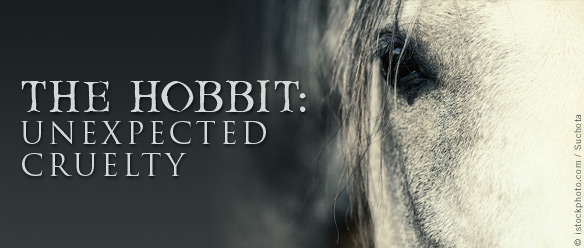

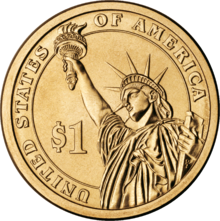

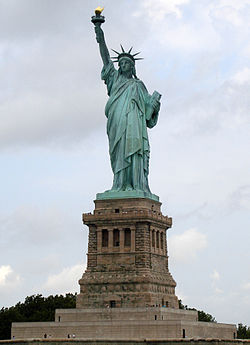




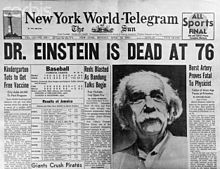
 RSS Feed
RSS Feed